An Analysis of Nintendo's Strategic Position in the Global Marketplace
VerifiedAdded on 2023/01/04
|19
|6740
|68
Report
AI Summary
This report provides a critical analysis of Nintendo's strategic position in the global marketplace, examining its readiness to compete, particularly in light of the COVID-19 pandemic and emerging markets. It evaluates Nintendo's external and internal environments, including industry rivalry and the threat of substitutes, as well as its organizational culture, leadership style, strategic intent, and strategy. The report assesses the fit between these elements, highlighting strengths and weaknesses, and explores the role of innovation and new product development in increasing organizational value and brand equity. The analysis considers factors such as staff, strategic intent, innovation management, and the impact of new product development on Nintendo's competitiveness. The report concludes with recommendations for Nintendo to enhance its global competitiveness through strategic diversification and new product developments, focusing on emerging markets and consumer trends.
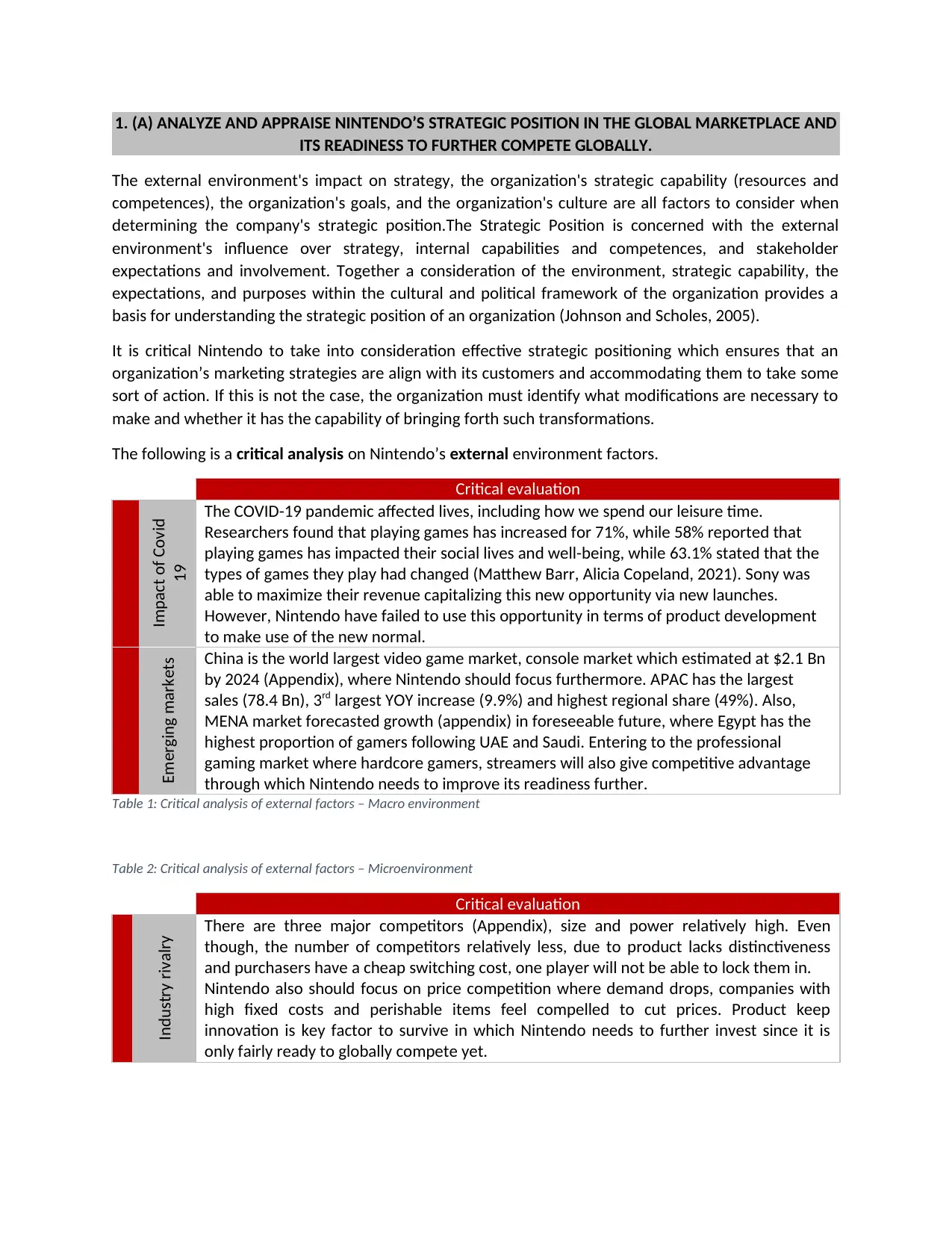
1. (A) ANALYZE AND APPRAISE NINTENDO’S STRATEGIC POSITION IN THE GLOBAL MARKETPLACE AND
ITS READINESS TO FURTHER COMPETE GLOBALLY.
The external environment's impact on strategy, the organization's strategic capability (resources and
competences), the organization's goals, and the organization's culture are all factors to consider when
determining the company's strategic position.The Strategic Position is concerned with the external
environment's influence over strategy, internal capabilities and competences, and stakeholder
expectations and involvement. Together a consideration of the environment, strategic capability, the
expectations, and purposes within the cultural and political framework of the organization provides a
basis for understanding the strategic position of an organization (Johnson and Scholes, 2005).
It is critical Nintendo to take into consideration effective strategic positioning which ensures that an
organization’s marketing strategies are align with its customers and accommodating them to take some
sort of action. If this is not the case, the organization must identify what modifications are necessary to
make and whether it has the capability of bringing forth such transformations.
The following is a critical analysis on Nintendo’s external environment factors.
Critical evaluation
Impact of Covid
19
The COVID-19 pandemic affected lives, including how we spend our leisure time.
Researchers found that playing games has increased for 71%, while 58% reported that
playing games has impacted their social lives and well-being, while 63.1% stated that the
types of games they play had changed (Matthew Barr, Alicia Copeland, 2021). Sony was
able to maximize their revenue capitalizing this new opportunity via new launches.
However, Nintendo have failed to use this opportunity in terms of product development
to make use of the new normal.
Emerging markets China is the world largest video game market, console market which estimated at $2.1 Bn
by 2024 (Appendix), where Nintendo should focus furthermore. APAC has the largest
sales (78.4 Bn), 3rd largest YOY increase (9.9%) and highest regional share (49%). Also,
MENA market forecasted growth (appendix) in foreseeable future, where Egypt has the
highest proportion of gamers following UAE and Saudi. Entering to the professional
gaming market where hardcore gamers, streamers will also give competitive advantage
through which Nintendo needs to improve its readiness further.
Table 1: Critical analysis of external factors – Macro environment
Table 2: Critical analysis of external factors – Microenvironment
Critical evaluation
Industry rivalry There are three major competitors (Appendix), size and power relatively high. Even
though, the number of competitors relatively less, due to product lacks distinctiveness
and purchasers have a cheap switching cost, one player will not be able to lock them in.
Nintendo also should focus on price competition where demand drops, companies with
high fixed costs and perishable items feel compelled to cut prices. Product keep
innovation is key factor to survive in which Nintendo needs to further invest since it is
only fairly ready to globally compete yet.
ITS READINESS TO FURTHER COMPETE GLOBALLY.
The external environment's impact on strategy, the organization's strategic capability (resources and
competences), the organization's goals, and the organization's culture are all factors to consider when
determining the company's strategic position.The Strategic Position is concerned with the external
environment's influence over strategy, internal capabilities and competences, and stakeholder
expectations and involvement. Together a consideration of the environment, strategic capability, the
expectations, and purposes within the cultural and political framework of the organization provides a
basis for understanding the strategic position of an organization (Johnson and Scholes, 2005).
It is critical Nintendo to take into consideration effective strategic positioning which ensures that an
organization’s marketing strategies are align with its customers and accommodating them to take some
sort of action. If this is not the case, the organization must identify what modifications are necessary to
make and whether it has the capability of bringing forth such transformations.
The following is a critical analysis on Nintendo’s external environment factors.
Critical evaluation
Impact of Covid
19
The COVID-19 pandemic affected lives, including how we spend our leisure time.
Researchers found that playing games has increased for 71%, while 58% reported that
playing games has impacted their social lives and well-being, while 63.1% stated that the
types of games they play had changed (Matthew Barr, Alicia Copeland, 2021). Sony was
able to maximize their revenue capitalizing this new opportunity via new launches.
However, Nintendo have failed to use this opportunity in terms of product development
to make use of the new normal.
Emerging markets China is the world largest video game market, console market which estimated at $2.1 Bn
by 2024 (Appendix), where Nintendo should focus furthermore. APAC has the largest
sales (78.4 Bn), 3rd largest YOY increase (9.9%) and highest regional share (49%). Also,
MENA market forecasted growth (appendix) in foreseeable future, where Egypt has the
highest proportion of gamers following UAE and Saudi. Entering to the professional
gaming market where hardcore gamers, streamers will also give competitive advantage
through which Nintendo needs to improve its readiness further.
Table 1: Critical analysis of external factors – Macro environment
Table 2: Critical analysis of external factors – Microenvironment
Critical evaluation
Industry rivalry There are three major competitors (Appendix), size and power relatively high. Even
though, the number of competitors relatively less, due to product lacks distinctiveness
and purchasers have a cheap switching cost, one player will not be able to lock them in.
Nintendo also should focus on price competition where demand drops, companies with
high fixed costs and perishable items feel compelled to cut prices. Product keep
innovation is key factor to survive in which Nintendo needs to further invest since it is
only fairly ready to globally compete yet.
Paraphrase This Document
Need a fresh take? Get an instant paraphrase of this document with our AI Paraphraser
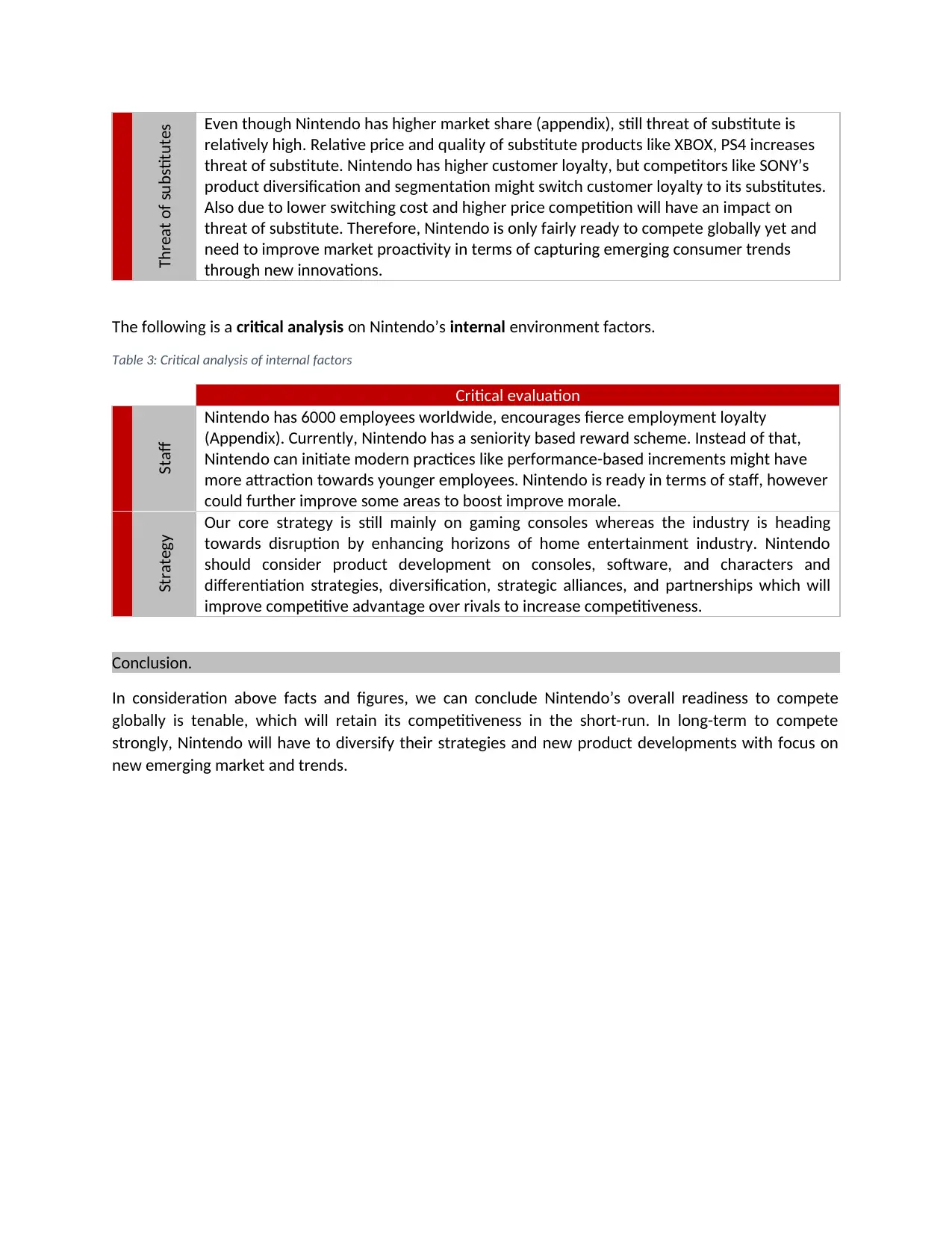
Threat of substitutes Even though Nintendo has higher market share (appendix), still threat of substitute is
relatively high. Relative price and quality of substitute products like XBOX, PS4 increases
threat of substitute. Nintendo has higher customer loyalty, but competitors like SONY’s
product diversification and segmentation might switch customer loyalty to its substitutes.
Also due to lower switching cost and higher price competition will have an impact on
threat of substitute. Therefore, Nintendo is only fairly ready to compete globally yet and
need to improve market proactivity in terms of capturing emerging consumer trends
through new innovations.
The following is a critical analysis on Nintendo’s internal environment factors.
Table 3: Critical analysis of internal factors
Critical evaluation
Staff
Nintendo has 6000 employees worldwide, encourages fierce employment loyalty
(Appendix). Currently, Nintendo has a seniority based reward scheme. Instead of that,
Nintendo can initiate modern practices like performance-based increments might have
more attraction towards younger employees. Nintendo is ready in terms of staff, however
could further improve some areas to boost improve morale.
Strategy Our core strategy is still mainly on gaming consoles whereas the industry is heading
towards disruption by enhancing horizons of home entertainment industry. Nintendo
should consider product development on consoles, software, and characters and
differentiation strategies, diversification, strategic alliances, and partnerships which will
improve competitive advantage over rivals to increase competitiveness.
Conclusion.
In consideration above facts and figures, we can conclude Nintendo’s overall readiness to compete
globally is tenable, which will retain its competitiveness in the short-run. In long-term to compete
strongly, Nintendo will have to diversify their strategies and new product developments with focus on
new emerging market and trends.
relatively high. Relative price and quality of substitute products like XBOX, PS4 increases
threat of substitute. Nintendo has higher customer loyalty, but competitors like SONY’s
product diversification and segmentation might switch customer loyalty to its substitutes.
Also due to lower switching cost and higher price competition will have an impact on
threat of substitute. Therefore, Nintendo is only fairly ready to compete globally yet and
need to improve market proactivity in terms of capturing emerging consumer trends
through new innovations.
The following is a critical analysis on Nintendo’s internal environment factors.
Table 3: Critical analysis of internal factors
Critical evaluation
Staff
Nintendo has 6000 employees worldwide, encourages fierce employment loyalty
(Appendix). Currently, Nintendo has a seniority based reward scheme. Instead of that,
Nintendo can initiate modern practices like performance-based increments might have
more attraction towards younger employees. Nintendo is ready in terms of staff, however
could further improve some areas to boost improve morale.
Strategy Our core strategy is still mainly on gaming consoles whereas the industry is heading
towards disruption by enhancing horizons of home entertainment industry. Nintendo
should consider product development on consoles, software, and characters and
differentiation strategies, diversification, strategic alliances, and partnerships which will
improve competitive advantage over rivals to increase competitiveness.
Conclusion.
In consideration above facts and figures, we can conclude Nintendo’s overall readiness to compete
globally is tenable, which will retain its competitiveness in the short-run. In long-term to compete
strongly, Nintendo will have to diversify their strategies and new product developments with focus on
new emerging market and trends.
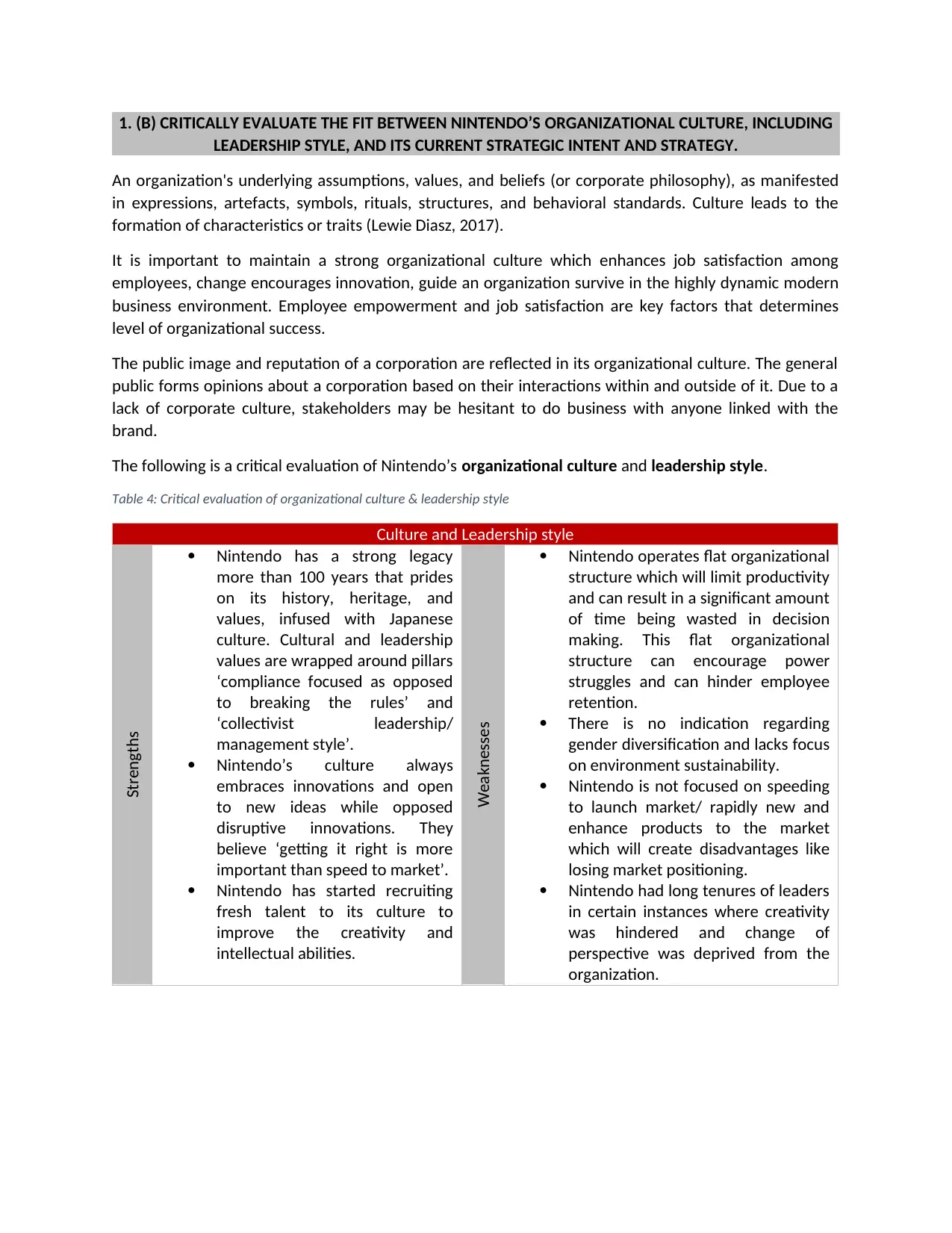
1. (B) CRITICALLY EVALUATE THE FIT BETWEEN NINTENDO’S ORGANIZATIONAL CULTURE, INCLUDING
LEADERSHIP STYLE, AND ITS CURRENT STRATEGIC INTENT AND STRATEGY.
An organization's underlying assumptions, values, and beliefs (or corporate philosophy), as manifested
in expressions, artefacts, symbols, rituals, structures, and behavioral standards. Culture leads to the
formation of characteristics or traits (Lewie Diasz, 2017).
It is important to maintain a strong organizational culture which enhances job satisfaction among
employees, change encourages innovation, guide an organization survive in the highly dynamic modern
business environment. Employee empowerment and job satisfaction are key factors that determines
level of organizational success.
The public image and reputation of a corporation are reflected in its organizational culture. The general
public forms opinions about a corporation based on their interactions within and outside of it. Due to a
lack of corporate culture, stakeholders may be hesitant to do business with anyone linked with the
brand.
The following is a critical evaluation of Nintendo’s organizational culture and leadership style.
Table 4: Critical evaluation of organizational culture & leadership style
Culture and Leadership style
Strengths
Nintendo has a strong legacy
more than 100 years that prides
on its history, heritage, and
values, infused with Japanese
culture. Cultural and leadership
values are wrapped around pillars
‘compliance focused as opposed
to breaking the rules’ and
‘collectivist leadership/
management style’.
Nintendo’s culture always
embraces innovations and open
to new ideas while opposed
disruptive innovations. They
believe ‘getting it right is more
important than speed to market’.
Nintendo has started recruiting
fresh talent to its culture to
improve the creativity and
intellectual abilities.
Weaknesses
Nintendo operates flat organizational
structure which will limit productivity
and can result in a significant amount
of time being wasted in decision
making. This flat organizational
structure can encourage power
struggles and can hinder employee
retention.
There is no indication regarding
gender diversification and lacks focus
on environment sustainability.
Nintendo is not focused on speeding
to launch market/ rapidly new and
enhance products to the market
which will create disadvantages like
losing market positioning.
Nintendo had long tenures of leaders
in certain instances where creativity
was hindered and change of
perspective was deprived from the
organization.
LEADERSHIP STYLE, AND ITS CURRENT STRATEGIC INTENT AND STRATEGY.
An organization's underlying assumptions, values, and beliefs (or corporate philosophy), as manifested
in expressions, artefacts, symbols, rituals, structures, and behavioral standards. Culture leads to the
formation of characteristics or traits (Lewie Diasz, 2017).
It is important to maintain a strong organizational culture which enhances job satisfaction among
employees, change encourages innovation, guide an organization survive in the highly dynamic modern
business environment. Employee empowerment and job satisfaction are key factors that determines
level of organizational success.
The public image and reputation of a corporation are reflected in its organizational culture. The general
public forms opinions about a corporation based on their interactions within and outside of it. Due to a
lack of corporate culture, stakeholders may be hesitant to do business with anyone linked with the
brand.
The following is a critical evaluation of Nintendo’s organizational culture and leadership style.
Table 4: Critical evaluation of organizational culture & leadership style
Culture and Leadership style
Strengths
Nintendo has a strong legacy
more than 100 years that prides
on its history, heritage, and
values, infused with Japanese
culture. Cultural and leadership
values are wrapped around pillars
‘compliance focused as opposed
to breaking the rules’ and
‘collectivist leadership/
management style’.
Nintendo’s culture always
embraces innovations and open
to new ideas while opposed
disruptive innovations. They
believe ‘getting it right is more
important than speed to market’.
Nintendo has started recruiting
fresh talent to its culture to
improve the creativity and
intellectual abilities.
Weaknesses
Nintendo operates flat organizational
structure which will limit productivity
and can result in a significant amount
of time being wasted in decision
making. This flat organizational
structure can encourage power
struggles and can hinder employee
retention.
There is no indication regarding
gender diversification and lacks focus
on environment sustainability.
Nintendo is not focused on speeding
to launch market/ rapidly new and
enhance products to the market
which will create disadvantages like
losing market positioning.
Nintendo had long tenures of leaders
in certain instances where creativity
was hindered and change of
perspective was deprived from the
organization.
⊘ This is a preview!⊘
Do you want full access?
Subscribe today to unlock all pages.

Trusted by 1+ million students worldwide
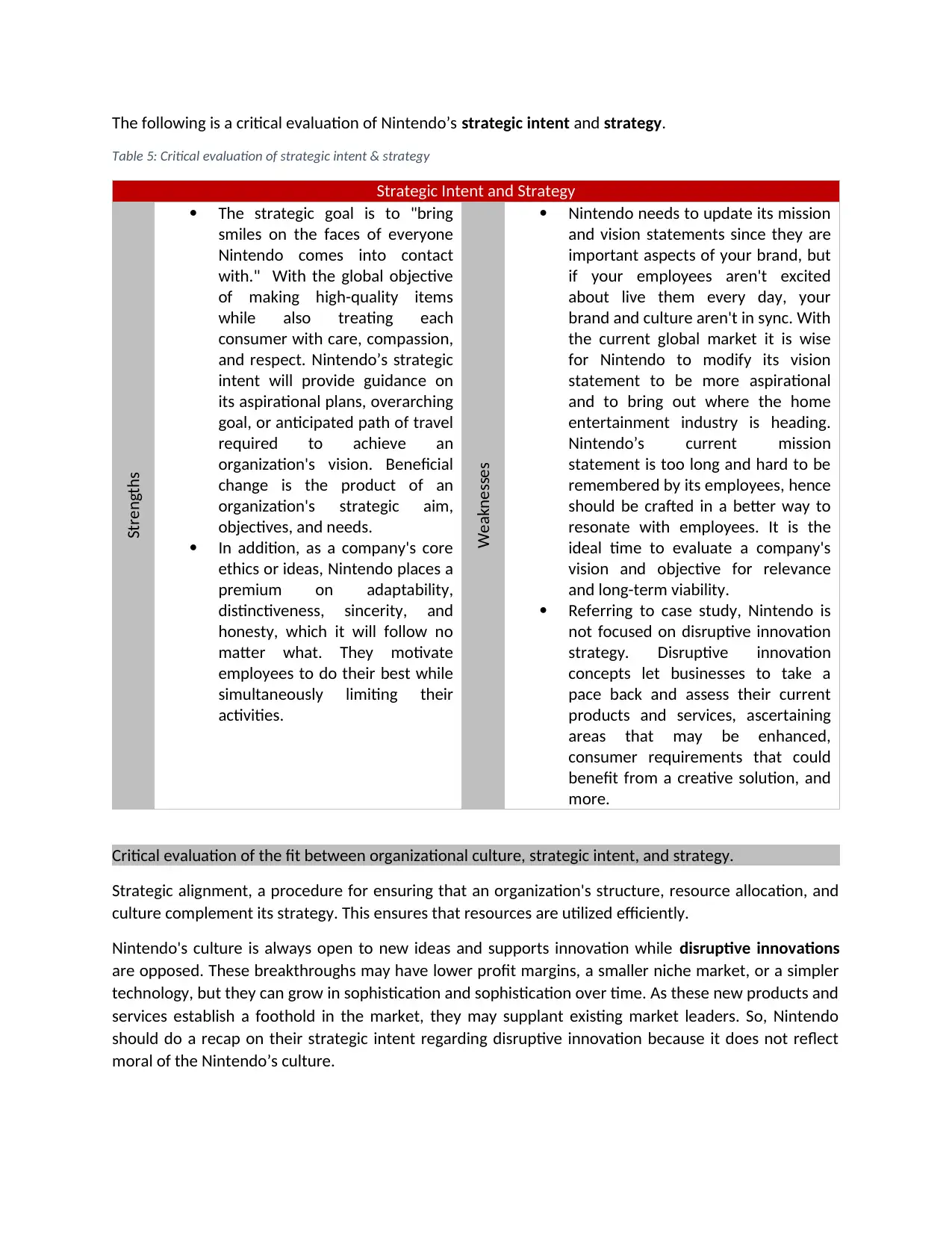
The following is a critical evaluation of Nintendo’s strategic intent and strategy.
Table 5: Critical evaluation of strategic intent & strategy
Strategic Intent and Strategy
Strengths
The strategic goal is to "bring
smiles on the faces of everyone
Nintendo comes into contact
with." With the global objective
of making high-quality items
while also treating each
consumer with care, compassion,
and respect. Nintendo’s strategic
intent will provide guidance on
its aspirational plans, overarching
goal, or anticipated path of travel
required to achieve an
organization's vision. Beneficial
change is the product of an
organization's strategic aim,
objectives, and needs.
In addition, as a company's core
ethics or ideas, Nintendo places a
premium on adaptability,
distinctiveness, sincerity, and
honesty, which it will follow no
matter what. They motivate
employees to do their best while
simultaneously limiting their
activities.
Weaknesses
Nintendo needs to update its mission
and vision statements since they are
important aspects of your brand, but
if your employees aren't excited
about live them every day, your
brand and culture aren't in sync. With
the current global market it is wise
for Nintendo to modify its vision
statement to be more aspirational
and to bring out where the home
entertainment industry is heading.
Nintendo’s current mission
statement is too long and hard to be
remembered by its employees, hence
should be crafted in a better way to
resonate with employees. It is the
ideal time to evaluate a company's
vision and objective for relevance
and long-term viability.
Referring to case study, Nintendo is
not focused on disruptive innovation
strategy. Disruptive innovation
concepts let businesses to take a
pace back and assess their current
products and services, ascertaining
areas that may be enhanced,
consumer requirements that could
benefit from a creative solution, and
more.
Critical evaluation of the fit between organizational culture, strategic intent, and strategy.
Strategic alignment, a procedure for ensuring that an organization's structure, resource allocation, and
culture complement its strategy. This ensures that resources are utilized efficiently.
Nintendo's culture is always open to new ideas and supports innovation while disruptive innovations
are opposed. These breakthroughs may have lower profit margins, a smaller niche market, or a simpler
technology, but they can grow in sophistication and sophistication over time. As these new products and
services establish a foothold in the market, they may supplant existing market leaders. So, Nintendo
should do a recap on their strategic intent regarding disruptive innovation because it does not reflect
moral of the Nintendo’s culture.
Table 5: Critical evaluation of strategic intent & strategy
Strategic Intent and Strategy
Strengths
The strategic goal is to "bring
smiles on the faces of everyone
Nintendo comes into contact
with." With the global objective
of making high-quality items
while also treating each
consumer with care, compassion,
and respect. Nintendo’s strategic
intent will provide guidance on
its aspirational plans, overarching
goal, or anticipated path of travel
required to achieve an
organization's vision. Beneficial
change is the product of an
organization's strategic aim,
objectives, and needs.
In addition, as a company's core
ethics or ideas, Nintendo places a
premium on adaptability,
distinctiveness, sincerity, and
honesty, which it will follow no
matter what. They motivate
employees to do their best while
simultaneously limiting their
activities.
Weaknesses
Nintendo needs to update its mission
and vision statements since they are
important aspects of your brand, but
if your employees aren't excited
about live them every day, your
brand and culture aren't in sync. With
the current global market it is wise
for Nintendo to modify its vision
statement to be more aspirational
and to bring out where the home
entertainment industry is heading.
Nintendo’s current mission
statement is too long and hard to be
remembered by its employees, hence
should be crafted in a better way to
resonate with employees. It is the
ideal time to evaluate a company's
vision and objective for relevance
and long-term viability.
Referring to case study, Nintendo is
not focused on disruptive innovation
strategy. Disruptive innovation
concepts let businesses to take a
pace back and assess their current
products and services, ascertaining
areas that may be enhanced,
consumer requirements that could
benefit from a creative solution, and
more.
Critical evaluation of the fit between organizational culture, strategic intent, and strategy.
Strategic alignment, a procedure for ensuring that an organization's structure, resource allocation, and
culture complement its strategy. This ensures that resources are utilized efficiently.
Nintendo's culture is always open to new ideas and supports innovation while disruptive innovations
are opposed. These breakthroughs may have lower profit margins, a smaller niche market, or a simpler
technology, but they can grow in sophistication and sophistication over time. As these new products and
services establish a foothold in the market, they may supplant existing market leaders. So, Nintendo
should do a recap on their strategic intent regarding disruptive innovation because it does not reflect
moral of the Nintendo’s culture.
Paraphrase This Document
Need a fresh take? Get an instant paraphrase of this document with our AI Paraphraser
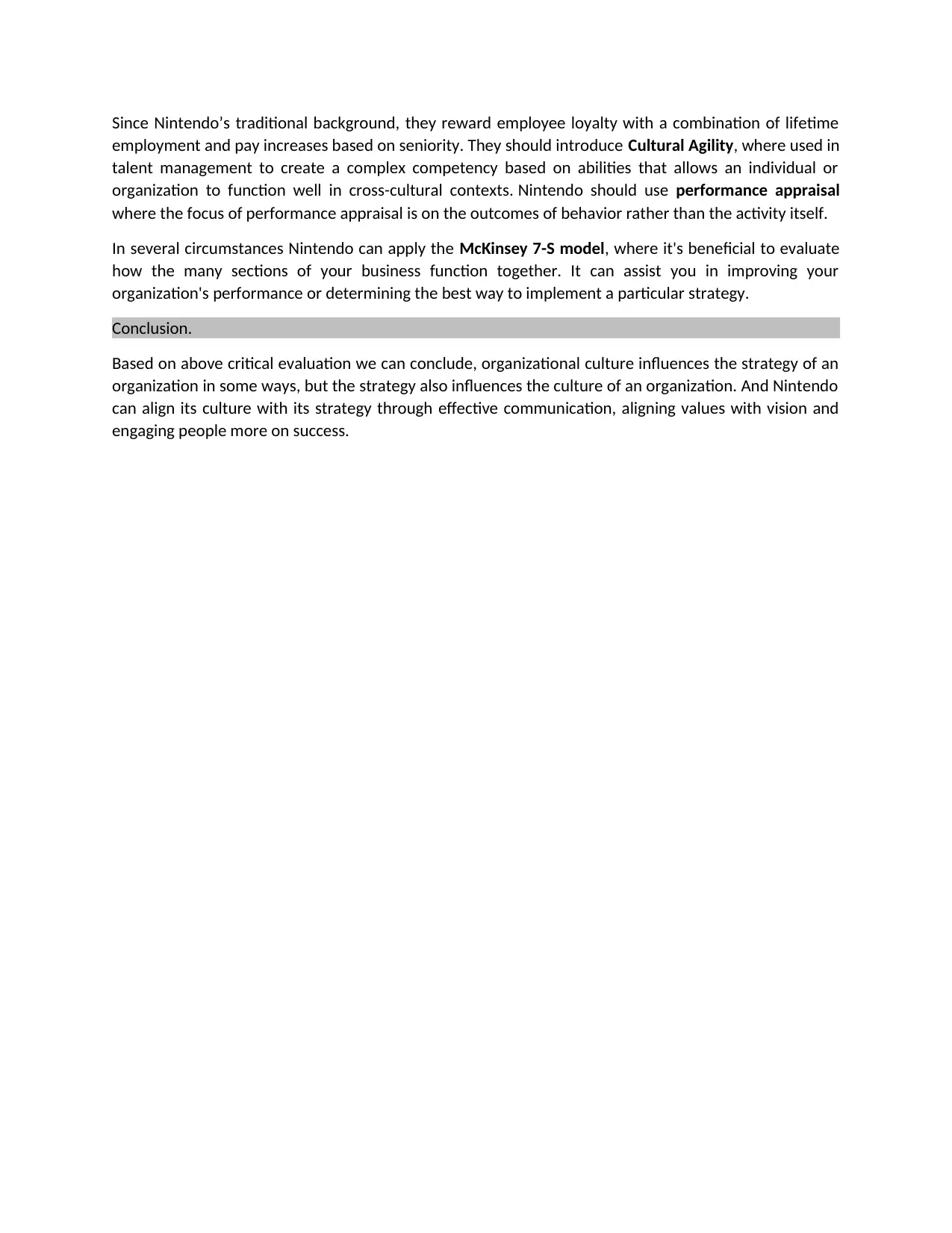
Since Nintendo’s traditional background, they reward employee loyalty with a combination of lifetime
employment and pay increases based on seniority. They should introduce Cultural Agility, where used in
talent management to create a complex competency based on abilities that allows an individual or
organization to function well in cross-cultural contexts. Nintendo should use performance appraisal
where the focus of performance appraisal is on the outcomes of behavior rather than the activity itself.
In several circumstances Nintendo can apply the McKinsey 7-S model, where it's beneficial to evaluate
how the many sections of your business function together. It can assist you in improving your
organization's performance or determining the best way to implement a particular strategy.
Conclusion.
Based on above critical evaluation we can conclude, organizational culture influences the strategy of an
organization in some ways, but the strategy also influences the culture of an organization. And Nintendo
can align its culture with its strategy through effective communication, aligning values with vision and
engaging people more on success.
employment and pay increases based on seniority. They should introduce Cultural Agility, where used in
talent management to create a complex competency based on abilities that allows an individual or
organization to function well in cross-cultural contexts. Nintendo should use performance appraisal
where the focus of performance appraisal is on the outcomes of behavior rather than the activity itself.
In several circumstances Nintendo can apply the McKinsey 7-S model, where it's beneficial to evaluate
how the many sections of your business function together. It can assist you in improving your
organization's performance or determining the best way to implement a particular strategy.
Conclusion.
Based on above critical evaluation we can conclude, organizational culture influences the strategy of an
organization in some ways, but the strategy also influences the culture of an organization. And Nintendo
can align its culture with its strategy through effective communication, aligning values with vision and
engaging people more on success.
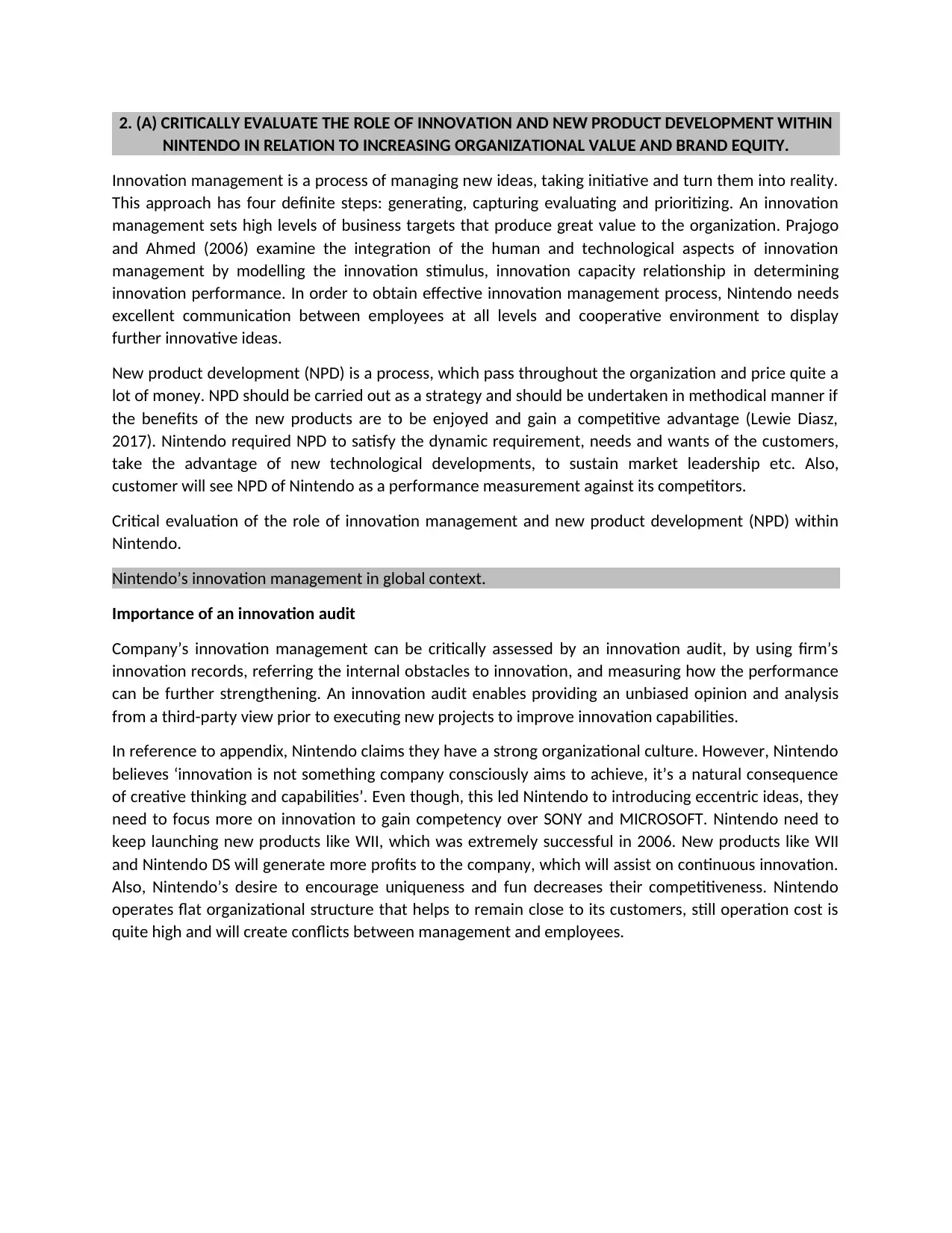
2. (A) CRITICALLY EVALUATE THE ROLE OF INNOVATION AND NEW PRODUCT DEVELOPMENT WITHIN
NINTENDO IN RELATION TO INCREASING ORGANIZATIONAL VALUE AND BRAND EQUITY.
Innovation management is a process of managing new ideas, taking initiative and turn them into reality.
This approach has four definite steps: generating, capturing evaluating and prioritizing. An innovation
management sets high levels of business targets that produce great value to the organization. Prajogo
and Ahmed (2006) examine the integration of the human and technological aspects of innovation
management by modelling the innovation stimulus, innovation capacity relationship in determining
innovation performance. In order to obtain effective innovation management process, Nintendo needs
excellent communication between employees at all levels and cooperative environment to display
further innovative ideas.
New product development (NPD) is a process, which pass throughout the organization and price quite a
lot of money. NPD should be carried out as a strategy and should be undertaken in methodical manner if
the benefits of the new products are to be enjoyed and gain a competitive advantage (Lewie Diasz,
2017). Nintendo required NPD to satisfy the dynamic requirement, needs and wants of the customers,
take the advantage of new technological developments, to sustain market leadership etc. Also,
customer will see NPD of Nintendo as a performance measurement against its competitors.
Critical evaluation of the role of innovation management and new product development (NPD) within
Nintendo.
Nintendo’s innovation management in global context.
Importance of an innovation audit
Company’s innovation management can be critically assessed by an innovation audit, by using firm’s
innovation records, referring the internal obstacles to innovation, and measuring how the performance
can be further strengthening. An innovation audit enables providing an unbiased opinion and analysis
from a third-party view prior to executing new projects to improve innovation capabilities.
In reference to appendix, Nintendo claims they have a strong organizational culture. However, Nintendo
believes ‘innovation is not something company consciously aims to achieve, it’s a natural consequence
of creative thinking and capabilities’. Even though, this led Nintendo to introducing eccentric ideas, they
need to focus more on innovation to gain competency over SONY and MICROSOFT. Nintendo need to
keep launching new products like WII, which was extremely successful in 2006. New products like WII
and Nintendo DS will generate more profits to the company, which will assist on continuous innovation.
Also, Nintendo’s desire to encourage uniqueness and fun decreases their competitiveness. Nintendo
operates flat organizational structure that helps to remain close to its customers, still operation cost is
quite high and will create conflicts between management and employees.
NINTENDO IN RELATION TO INCREASING ORGANIZATIONAL VALUE AND BRAND EQUITY.
Innovation management is a process of managing new ideas, taking initiative and turn them into reality.
This approach has four definite steps: generating, capturing evaluating and prioritizing. An innovation
management sets high levels of business targets that produce great value to the organization. Prajogo
and Ahmed (2006) examine the integration of the human and technological aspects of innovation
management by modelling the innovation stimulus, innovation capacity relationship in determining
innovation performance. In order to obtain effective innovation management process, Nintendo needs
excellent communication between employees at all levels and cooperative environment to display
further innovative ideas.
New product development (NPD) is a process, which pass throughout the organization and price quite a
lot of money. NPD should be carried out as a strategy and should be undertaken in methodical manner if
the benefits of the new products are to be enjoyed and gain a competitive advantage (Lewie Diasz,
2017). Nintendo required NPD to satisfy the dynamic requirement, needs and wants of the customers,
take the advantage of new technological developments, to sustain market leadership etc. Also,
customer will see NPD of Nintendo as a performance measurement against its competitors.
Critical evaluation of the role of innovation management and new product development (NPD) within
Nintendo.
Nintendo’s innovation management in global context.
Importance of an innovation audit
Company’s innovation management can be critically assessed by an innovation audit, by using firm’s
innovation records, referring the internal obstacles to innovation, and measuring how the performance
can be further strengthening. An innovation audit enables providing an unbiased opinion and analysis
from a third-party view prior to executing new projects to improve innovation capabilities.
In reference to appendix, Nintendo claims they have a strong organizational culture. However, Nintendo
believes ‘innovation is not something company consciously aims to achieve, it’s a natural consequence
of creative thinking and capabilities’. Even though, this led Nintendo to introducing eccentric ideas, they
need to focus more on innovation to gain competency over SONY and MICROSOFT. Nintendo need to
keep launching new products like WII, which was extremely successful in 2006. New products like WII
and Nintendo DS will generate more profits to the company, which will assist on continuous innovation.
Also, Nintendo’s desire to encourage uniqueness and fun decreases their competitiveness. Nintendo
operates flat organizational structure that helps to remain close to its customers, still operation cost is
quite high and will create conflicts between management and employees.
⊘ This is a preview!⊘
Do you want full access?
Subscribe today to unlock all pages.

Trusted by 1+ million students worldwide

4 Ps of innovation
Innovation can be described in a variety of ways, but it can be simplified down to four distinct shift
orientations.
Table 6: 4 Ps of innovation
4 Ps of innovation
Product innovation Process innovation Position innovation Paradigm innovation
Nintendo introduced
different product types
from Game Boy,
Nintendo WII and Switch
throughout the time
which shows their ability
to innovate.
Nintendo WII was
targeted customers
who are Looking for
low-cost
entertainment with
family and friends
requires only a few
skills. Nintendo DS Lite
featured brighter
screens and a slimmer
design.
Nintendo is providing
an opportunity to its
customers engage with
Nintendo IP on smart
devices and by
expanding the interest
of the Nintendo’s
characters through
collaborations with its
partners which will
gain competitive
advantage.
Need significant
improvement in their
current business
model or implement
new business model
(ex. Entertainment
industry).
Innovation types used by Nintendo.
Disruptive innovation is an innovation that helps create a new market and value network, and
eventually disrupts an existing market and value network (over a few years or decades), displacing an
earlier technology (Lewie Diasz, 2017). This term is used in business and technology models to express
an innovation which enhance a product or service in a way market does not anticipate.
In reference to the case study, Nintendo has not done disruptive innovations which is a major drawback
since its rivals already moving with disruptive innovation models. As an example, RIOT GAMES and
Graph 1: Disruptive innovation
Innovation can be described in a variety of ways, but it can be simplified down to four distinct shift
orientations.
Table 6: 4 Ps of innovation
4 Ps of innovation
Product innovation Process innovation Position innovation Paradigm innovation
Nintendo introduced
different product types
from Game Boy,
Nintendo WII and Switch
throughout the time
which shows their ability
to innovate.
Nintendo WII was
targeted customers
who are Looking for
low-cost
entertainment with
family and friends
requires only a few
skills. Nintendo DS Lite
featured brighter
screens and a slimmer
design.
Nintendo is providing
an opportunity to its
customers engage with
Nintendo IP on smart
devices and by
expanding the interest
of the Nintendo’s
characters through
collaborations with its
partners which will
gain competitive
advantage.
Need significant
improvement in their
current business
model or implement
new business model
(ex. Entertainment
industry).
Innovation types used by Nintendo.
Disruptive innovation is an innovation that helps create a new market and value network, and
eventually disrupts an existing market and value network (over a few years or decades), displacing an
earlier technology (Lewie Diasz, 2017). This term is used in business and technology models to express
an innovation which enhance a product or service in a way market does not anticipate.
In reference to the case study, Nintendo has not done disruptive innovations which is a major drawback
since its rivals already moving with disruptive innovation models. As an example, RIOT GAMES and
Graph 1: Disruptive innovation
Paraphrase This Document
Need a fresh take? Get an instant paraphrase of this document with our AI Paraphraser

SUPERCELL OY already formed alliances with NVIDIA to launch the cloud gaming service START, NETFLIX
has introduced new subscription model which is a huge success. Nintendo must move out from its
traditional console-based gaming model to new disruptive model to succeed in long-term.
Sustaining innovation aims to improve existing products and processes, rather than creating new
markets, by making existing ones more valuable. Sustaining innovation can be divided into two pillars
continuous innovation and dis-continuous innovation.
Nintendo’s GAME BOY and SWITCH platforms are its continuous innovations. These products follow on
from its previous versions and is identifiably obtain from its predecessor. Nintendo’s GAME BOY was a
huge success following GAME BOY ADVANCE came to market in 2001.
Nintendo’s WII platform is its discontinuous innovation which was legitimately new to the market at that
time that made revolutionary change to gaming industry.
Innovation friendly culture.
Nintendo’s culture is desire to see what they can be done to amaze players. Even though, Nintendo’s
primary goal does not aim to an innovation, they believe innovation can be achieve through creative
thinking and competencies. Nintendo always recruits new talents to manage their future developments.
Also, Nintendo follows ‘collective leadership system’ where people come together to make decisions.
Within this process, people can collectively involve in share their experiences and interactions to shape
their decisions to obtain desired results.
Impact on value creation and brand equity.
Enhance value creation
As per above evaluation, it is important to enhance customer value, disruptive innovation mainly assist
to accomplish customer satisfaction index while reinforcing the brand promise. Also, Nintendo needs to
increase points of differentiation by capitalizing emerging market trends and improving the quality of
new products and innovations will increase the value generated for the consumers. With the current
evolving market trends and consumer needs Nintendo needs to further invest in disruptive innovation to
maintain the top of mind recall of consumers. Currently, Nintendo is absent in this area, whereas
competitors are enjoying the first mover advantages which should be changed. By engaging in
innovation Nintendo will create a positive impact for the consumers creating a strategic lock in
successfully to lock In consumers.
In addition, Nintendo should adopt a closed
innovation approach which would enable them to
protect its intellectual property and enjoy first
mover advantage in the market. This would
enable them to command a premium price for its
products in the market which would eventually
lead to enhancing shareholder value through
appreciation of share price. As shown in the graph
during year 2017, Nintendo’s profit per share has
significantly increased mainly due to the launch of
has introduced new subscription model which is a huge success. Nintendo must move out from its
traditional console-based gaming model to new disruptive model to succeed in long-term.
Sustaining innovation aims to improve existing products and processes, rather than creating new
markets, by making existing ones more valuable. Sustaining innovation can be divided into two pillars
continuous innovation and dis-continuous innovation.
Nintendo’s GAME BOY and SWITCH platforms are its continuous innovations. These products follow on
from its previous versions and is identifiably obtain from its predecessor. Nintendo’s GAME BOY was a
huge success following GAME BOY ADVANCE came to market in 2001.
Nintendo’s WII platform is its discontinuous innovation which was legitimately new to the market at that
time that made revolutionary change to gaming industry.
Innovation friendly culture.
Nintendo’s culture is desire to see what they can be done to amaze players. Even though, Nintendo’s
primary goal does not aim to an innovation, they believe innovation can be achieve through creative
thinking and competencies. Nintendo always recruits new talents to manage their future developments.
Also, Nintendo follows ‘collective leadership system’ where people come together to make decisions.
Within this process, people can collectively involve in share their experiences and interactions to shape
their decisions to obtain desired results.
Impact on value creation and brand equity.
Enhance value creation
As per above evaluation, it is important to enhance customer value, disruptive innovation mainly assist
to accomplish customer satisfaction index while reinforcing the brand promise. Also, Nintendo needs to
increase points of differentiation by capitalizing emerging market trends and improving the quality of
new products and innovations will increase the value generated for the consumers. With the current
evolving market trends and consumer needs Nintendo needs to further invest in disruptive innovation to
maintain the top of mind recall of consumers. Currently, Nintendo is absent in this area, whereas
competitors are enjoying the first mover advantages which should be changed. By engaging in
innovation Nintendo will create a positive impact for the consumers creating a strategic lock in
successfully to lock In consumers.
In addition, Nintendo should adopt a closed
innovation approach which would enable them to
protect its intellectual property and enjoy first
mover advantage in the market. This would
enable them to command a premium price for its
products in the market which would eventually
lead to enhancing shareholder value through
appreciation of share price. As shown in the graph
during year 2017, Nintendo’s profit per share has
significantly increased mainly due to the launch of
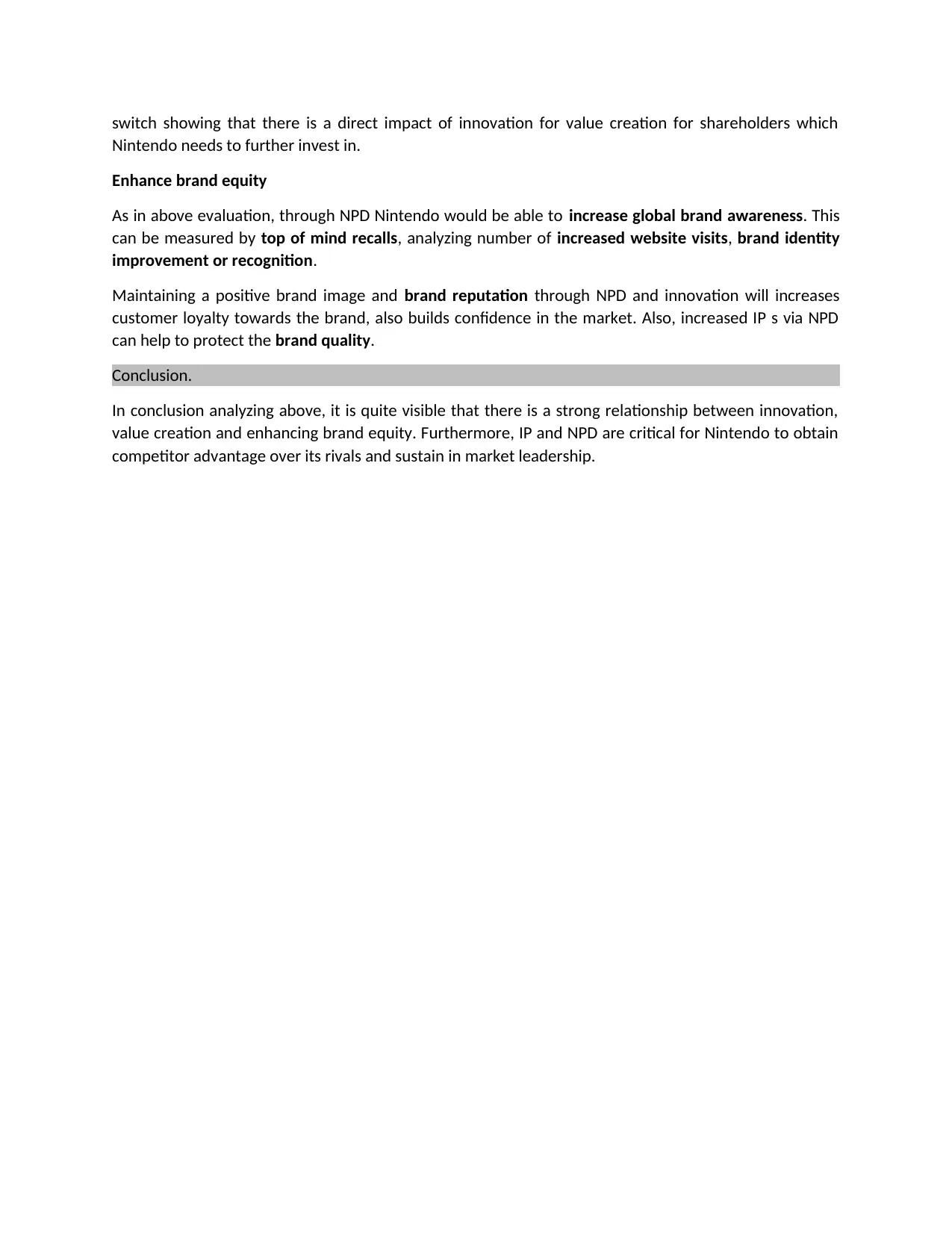
switch showing that there is a direct impact of innovation for value creation for shareholders which
Nintendo needs to further invest in.
Enhance brand equity
As in above evaluation, through NPD Nintendo would be able to increase global brand awareness. This
can be measured by top of mind recalls, analyzing number of increased website visits, brand identity
improvement or recognition.
Maintaining a positive brand image and brand reputation through NPD and innovation will increases
customer loyalty towards the brand, also builds confidence in the market. Also, increased IP s via NPD
can help to protect the brand quality.
Conclusion.
In conclusion analyzing above, it is quite visible that there is a strong relationship between innovation,
value creation and enhancing brand equity. Furthermore, IP and NPD are critical for Nintendo to obtain
competitor advantage over its rivals and sustain in market leadership.
Nintendo needs to further invest in.
Enhance brand equity
As in above evaluation, through NPD Nintendo would be able to increase global brand awareness. This
can be measured by top of mind recalls, analyzing number of increased website visits, brand identity
improvement or recognition.
Maintaining a positive brand image and brand reputation through NPD and innovation will increases
customer loyalty towards the brand, also builds confidence in the market. Also, increased IP s via NPD
can help to protect the brand quality.
Conclusion.
In conclusion analyzing above, it is quite visible that there is a strong relationship between innovation,
value creation and enhancing brand equity. Furthermore, IP and NPD are critical for Nintendo to obtain
competitor advantage over its rivals and sustain in market leadership.
⊘ This is a preview!⊘
Do you want full access?
Subscribe today to unlock all pages.

Trusted by 1+ million students worldwide
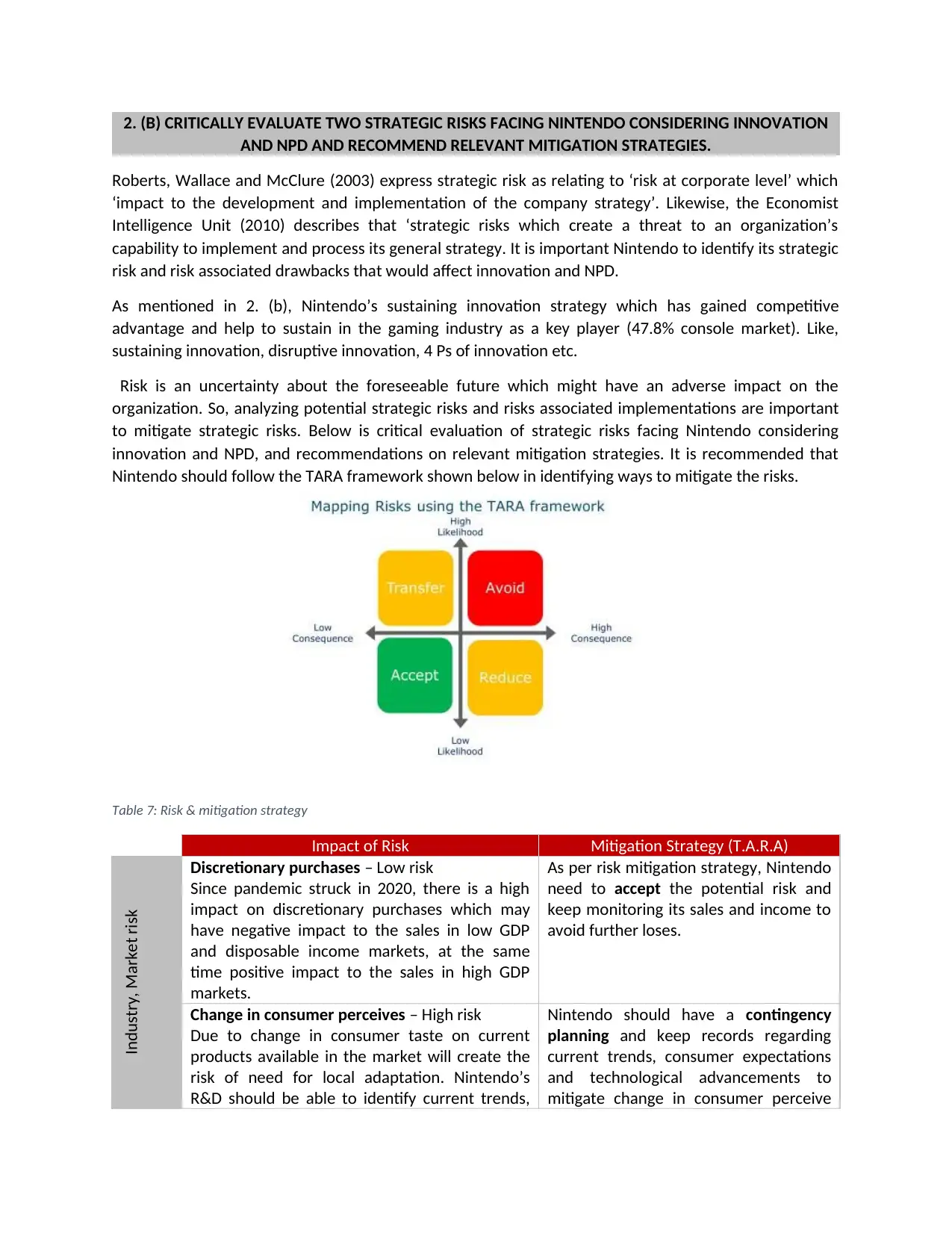
2. (B) CRITICALLY EVALUATE TWO STRATEGIC RISKS FACING NINTENDO CONSIDERING INNOVATION
AND NPD AND RECOMMEND RELEVANT MITIGATION STRATEGIES.
Roberts, Wallace and McClure (2003) express strategic risk as relating to ‘risk at corporate level’ which
‘impact to the development and implementation of the company strategy’. Likewise, the Economist
Intelligence Unit (2010) describes that ‘strategic risks which create a threat to an organization’s
capability to implement and process its general strategy. It is important Nintendo to identify its strategic
risk and risk associated drawbacks that would affect innovation and NPD.
As mentioned in 2. (b), Nintendo’s sustaining innovation strategy which has gained competitive
advantage and help to sustain in the gaming industry as a key player (47.8% console market). Like,
sustaining innovation, disruptive innovation, 4 Ps of innovation etc.
Risk is an uncertainty about the foreseeable future which might have an adverse impact on the
organization. So, analyzing potential strategic risks and risks associated implementations are important
to mitigate strategic risks. Below is critical evaluation of strategic risks facing Nintendo considering
innovation and NPD, and recommendations on relevant mitigation strategies. It is recommended that
Nintendo should follow the TARA framework shown below in identifying ways to mitigate the risks.
Table 7: Risk & mitigation strategy
Impact of Risk Mitigation Strategy (T.A.R.A)
Industry, Market risk
Discretionary purchases – Low risk
Since pandemic struck in 2020, there is a high
impact on discretionary purchases which may
have negative impact to the sales in low GDP
and disposable income markets, at the same
time positive impact to the sales in high GDP
markets.
As per risk mitigation strategy, Nintendo
need to accept the potential risk and
keep monitoring its sales and income to
avoid further loses.
Change in consumer perceives – High risk
Due to change in consumer taste on current
products available in the market will create the
risk of need for local adaptation. Nintendo’s
R&D should be able to identify current trends,
Nintendo should have a contingency
planning and keep records regarding
current trends, consumer expectations
and technological advancements to
mitigate change in consumer perceive
AND NPD AND RECOMMEND RELEVANT MITIGATION STRATEGIES.
Roberts, Wallace and McClure (2003) express strategic risk as relating to ‘risk at corporate level’ which
‘impact to the development and implementation of the company strategy’. Likewise, the Economist
Intelligence Unit (2010) describes that ‘strategic risks which create a threat to an organization’s
capability to implement and process its general strategy. It is important Nintendo to identify its strategic
risk and risk associated drawbacks that would affect innovation and NPD.
As mentioned in 2. (b), Nintendo’s sustaining innovation strategy which has gained competitive
advantage and help to sustain in the gaming industry as a key player (47.8% console market). Like,
sustaining innovation, disruptive innovation, 4 Ps of innovation etc.
Risk is an uncertainty about the foreseeable future which might have an adverse impact on the
organization. So, analyzing potential strategic risks and risks associated implementations are important
to mitigate strategic risks. Below is critical evaluation of strategic risks facing Nintendo considering
innovation and NPD, and recommendations on relevant mitigation strategies. It is recommended that
Nintendo should follow the TARA framework shown below in identifying ways to mitigate the risks.
Table 7: Risk & mitigation strategy
Impact of Risk Mitigation Strategy (T.A.R.A)
Industry, Market risk
Discretionary purchases – Low risk
Since pandemic struck in 2020, there is a high
impact on discretionary purchases which may
have negative impact to the sales in low GDP
and disposable income markets, at the same
time positive impact to the sales in high GDP
markets.
As per risk mitigation strategy, Nintendo
need to accept the potential risk and
keep monitoring its sales and income to
avoid further loses.
Change in consumer perceives – High risk
Due to change in consumer taste on current
products available in the market will create the
risk of need for local adaptation. Nintendo’s
R&D should be able to identify current trends,
Nintendo should have a contingency
planning and keep records regarding
current trends, consumer expectations
and technological advancements to
mitigate change in consumer perceive
Paraphrase This Document
Need a fresh take? Get an instant paraphrase of this document with our AI Paraphraser
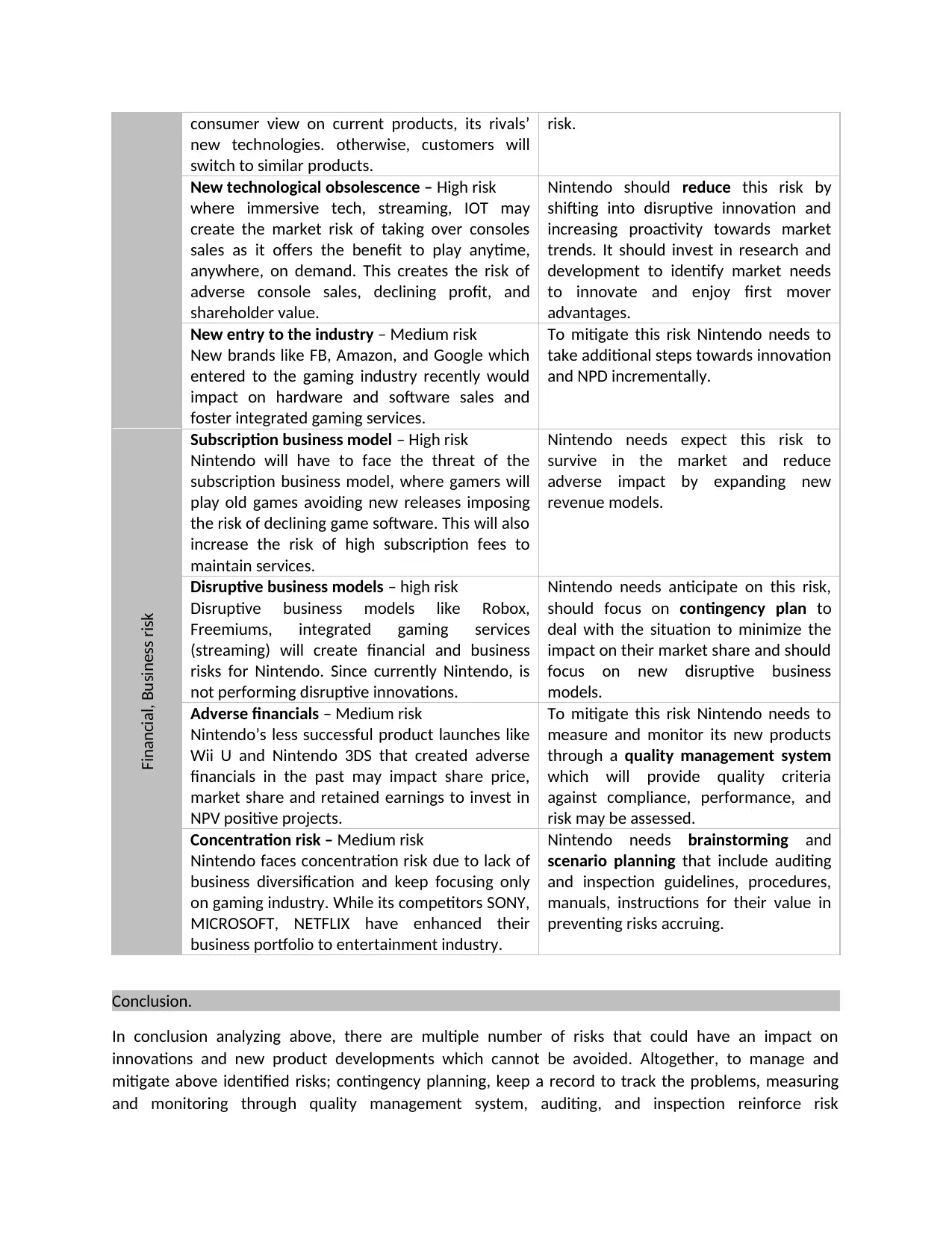
consumer view on current products, its rivals’
new technologies. otherwise, customers will
switch to similar products.
risk.
New technological obsolescence – High risk
where immersive tech, streaming, IOT may
create the market risk of taking over consoles
sales as it offers the benefit to play anytime,
anywhere, on demand. This creates the risk of
adverse console sales, declining profit, and
shareholder value.
Nintendo should reduce this risk by
shifting into disruptive innovation and
increasing proactivity towards market
trends. It should invest in research and
development to identify market needs
to innovate and enjoy first mover
advantages.
New entry to the industry – Medium risk
New brands like FB, Amazon, and Google which
entered to the gaming industry recently would
impact on hardware and software sales and
foster integrated gaming services.
To mitigate this risk Nintendo needs to
take additional steps towards innovation
and NPD incrementally.
Financial, Business risk
Subscription business model – High risk
Nintendo will have to face the threat of the
subscription business model, where gamers will
play old games avoiding new releases imposing
the risk of declining game software. This will also
increase the risk of high subscription fees to
maintain services.
Nintendo needs expect this risk to
survive in the market and reduce
adverse impact by expanding new
revenue models.
Disruptive business models – high risk
Disruptive business models like Robox,
Freemiums, integrated gaming services
(streaming) will create financial and business
risks for Nintendo. Since currently Nintendo, is
not performing disruptive innovations.
Nintendo needs anticipate on this risk,
should focus on contingency plan to
deal with the situation to minimize the
impact on their market share and should
focus on new disruptive business
models.
Adverse financials – Medium risk
Nintendo’s less successful product launches like
Wii U and Nintendo 3DS that created adverse
financials in the past may impact share price,
market share and retained earnings to invest in
NPV positive projects.
To mitigate this risk Nintendo needs to
measure and monitor its new products
through a quality management system
which will provide quality criteria
against compliance, performance, and
risk may be assessed.
Concentration risk – Medium risk
Nintendo faces concentration risk due to lack of
business diversification and keep focusing only
on gaming industry. While its competitors SONY,
MICROSOFT, NETFLIX have enhanced their
business portfolio to entertainment industry.
Nintendo needs brainstorming and
scenario planning that include auditing
and inspection guidelines, procedures,
manuals, instructions for their value in
preventing risks accruing.
Conclusion.
In conclusion analyzing above, there are multiple number of risks that could have an impact on
innovations and new product developments which cannot be avoided. Altogether, to manage and
mitigate above identified risks; contingency planning, keep a record to track the problems, measuring
and monitoring through quality management system, auditing, and inspection reinforce risk
new technologies. otherwise, customers will
switch to similar products.
risk.
New technological obsolescence – High risk
where immersive tech, streaming, IOT may
create the market risk of taking over consoles
sales as it offers the benefit to play anytime,
anywhere, on demand. This creates the risk of
adverse console sales, declining profit, and
shareholder value.
Nintendo should reduce this risk by
shifting into disruptive innovation and
increasing proactivity towards market
trends. It should invest in research and
development to identify market needs
to innovate and enjoy first mover
advantages.
New entry to the industry – Medium risk
New brands like FB, Amazon, and Google which
entered to the gaming industry recently would
impact on hardware and software sales and
foster integrated gaming services.
To mitigate this risk Nintendo needs to
take additional steps towards innovation
and NPD incrementally.
Financial, Business risk
Subscription business model – High risk
Nintendo will have to face the threat of the
subscription business model, where gamers will
play old games avoiding new releases imposing
the risk of declining game software. This will also
increase the risk of high subscription fees to
maintain services.
Nintendo needs expect this risk to
survive in the market and reduce
adverse impact by expanding new
revenue models.
Disruptive business models – high risk
Disruptive business models like Robox,
Freemiums, integrated gaming services
(streaming) will create financial and business
risks for Nintendo. Since currently Nintendo, is
not performing disruptive innovations.
Nintendo needs anticipate on this risk,
should focus on contingency plan to
deal with the situation to minimize the
impact on their market share and should
focus on new disruptive business
models.
Adverse financials – Medium risk
Nintendo’s less successful product launches like
Wii U and Nintendo 3DS that created adverse
financials in the past may impact share price,
market share and retained earnings to invest in
NPV positive projects.
To mitigate this risk Nintendo needs to
measure and monitor its new products
through a quality management system
which will provide quality criteria
against compliance, performance, and
risk may be assessed.
Concentration risk – Medium risk
Nintendo faces concentration risk due to lack of
business diversification and keep focusing only
on gaming industry. While its competitors SONY,
MICROSOFT, NETFLIX have enhanced their
business portfolio to entertainment industry.
Nintendo needs brainstorming and
scenario planning that include auditing
and inspection guidelines, procedures,
manuals, instructions for their value in
preventing risks accruing.
Conclusion.
In conclusion analyzing above, there are multiple number of risks that could have an impact on
innovations and new product developments which cannot be avoided. Altogether, to manage and
mitigate above identified risks; contingency planning, keep a record to track the problems, measuring
and monitoring through quality management system, auditing, and inspection reinforce risk
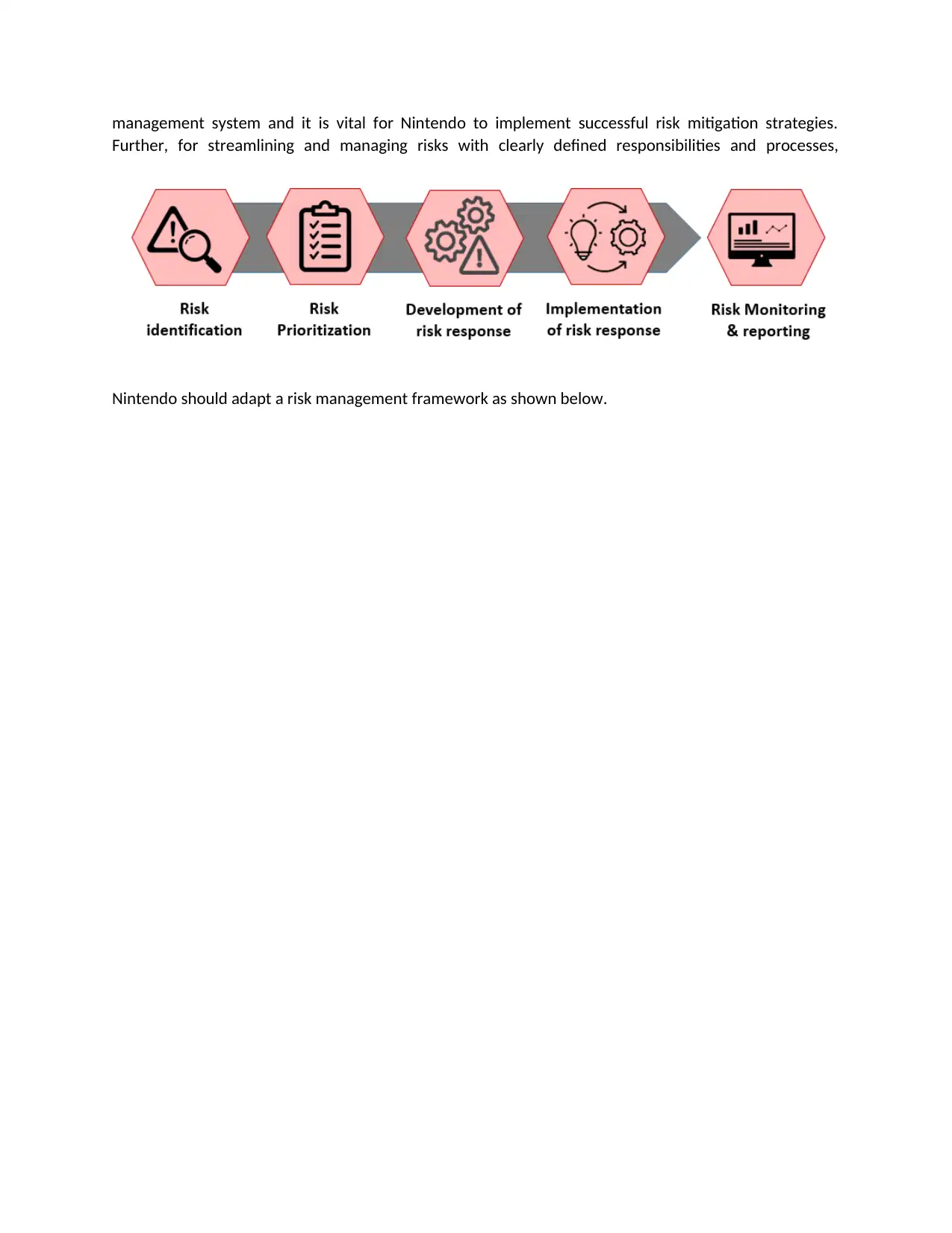
management system and it is vital for Nintendo to implement successful risk mitigation strategies.
Further, for streamlining and managing risks with clearly defined responsibilities and processes,
Nintendo should adapt a risk management framework as shown below.
Further, for streamlining and managing risks with clearly defined responsibilities and processes,
Nintendo should adapt a risk management framework as shown below.
⊘ This is a preview!⊘
Do you want full access?
Subscribe today to unlock all pages.

Trusted by 1+ million students worldwide
1 out of 19
Related Documents
Your All-in-One AI-Powered Toolkit for Academic Success.
+13062052269
info@desklib.com
Available 24*7 on WhatsApp / Email
![[object Object]](/_next/static/media/star-bottom.7253800d.svg)
Unlock your academic potential
Copyright © 2020–2025 A2Z Services. All Rights Reserved. Developed and managed by ZUCOL.





